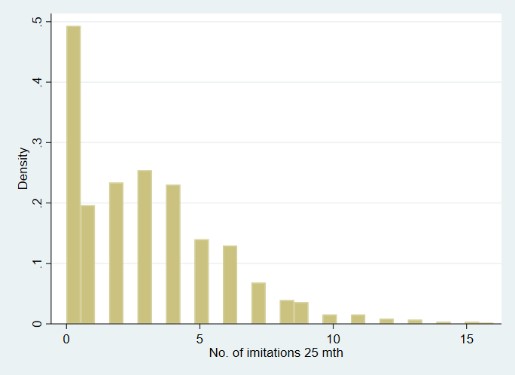The Avon Longitudinal Study of Parents and Children (ALSPAC) assessed their cohort members (CMs) at 25 months’ age (Children in Focus Clinic) using the Object Naming Assessment.
Details on this measure, a phonology screening procedure, and the data collected from the CMs are outlined in the table below.
| Year of data collection: | 1994-1995 |
| Domain: | Verbal knowledge (expressive and spoken) |
| Measures: | Speech and sound production |
| Oral production and fluency | |
| General verbal information | |
| CHC: | Gc (Crystallised Intelligence) |
| CLOSER Source: | Explore this sweep in CLOSER Discovery: ALSPAC Early Years (13 months to 4 years 11 months) (opens in a new tab) |
| Administration method: | Trained interviewer; clinical setting; guided play session |
| Procedure: | The tester chose an object from a box and asked the child to name it. If the child was reluctant, they were encouraged to choose an object themselves and name it. If a child failed to name an object after 3 requests, the tester named it clearly for the child, and encouraged imitation. The number of errors made by the child in each sound class was recorded and the percentage error calculated from those words attempted. |
| Link to questionnaire: | http://www.bristol.ac.uk/alspac/researchers/our-data/clinical-measures/ (opens in new tab) |
| Scoring: | Number of imitations (0 - 16) |
| Item-level variable(s): | Not readily available |
| Total score/derived variable(s): | cf428 – cf435 Explore these variables in CLOSER Discovery: ALSPAC Children in Focus 4Mth-61Mth Clinics Dataset (opens in a new tab) |
| Descriptives: | Number of imitations |
| N = 1,099 | |
| Range = 0 - 16 | |
| Mean = 2.97 | |
| SD = 2.83 | |
(click image to enlarge) |
|
| Age of participants (weeks): | Mean = 108.24 weeks, SD =0.98, Range = 106 - 115 |
| Other sweep and/or cohort: | MCS – Age 3 – BAS II Naming Vocabulary |
| MCS – Age 5 – BAS II Naming Vocabulary (similar object naming task involving pictures) | |
| BCS70 – Child of CM (Multi-Age) – BAS Naming Vocabulary (similar object naming task involving pictures) | |
| Source: | Adapted from a similar procedure devised by Paden, Novak & Beiter (1987) |
| Technical resources: | None |
| Example articles: | Roulstone, S., Loader, S., Northstone, K., & Beveridge, M. (2002). The speech and language of children aged 25 months: Descriptive data from the Avon Longitudinal Study of Parents and Children. Early Child Development and Care, 172(3), 259-268. |
For the named items in the table above, links are provided (where applicable) to their corresponding content on CLOSER Discovery. Where a variable range is provided, full variable lists can be accessed through the ‘Variable Groups’ tab on the linked Discovery page.
Go to:
- Overview of all cognitive measures in ALSPAC
- Overview of childhood cognitive measures across all studies
This page is part of CLOSER’s ‘A guide to the cognitive measures in five British birth cohort studies’.
